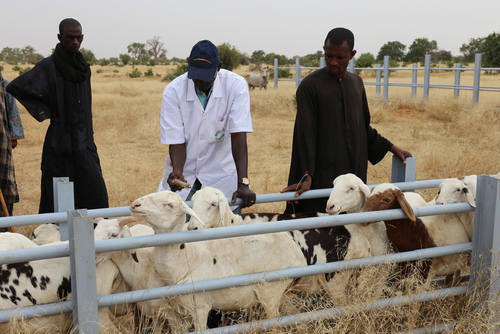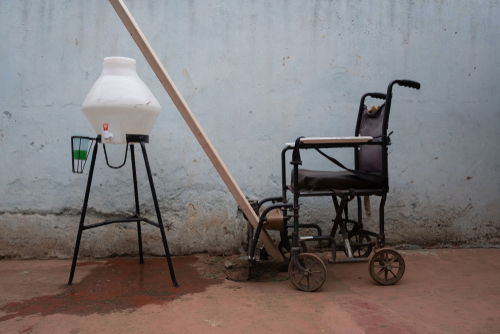April 22, 2024

Test scores decline when taken within one hour of eating a meal.
Through analysis of novel time use data from around 4,600 Indian adolescents and young adults, OHT researchers Ramanan Laxminarayan and Arindam Nandi and collaborators found that test-taking within 1 hour after eating a meal reduced scores on English, native language, math, and fluid intelligence tests by 8, 8, 8, and 16 percent, respectively, compared to individuals who took the tests more than 1 hour after a meal. These reductions can be attributed to postprandial somnolence, colloquially known as a “food coma,” and may explain the positive effects of daytime naps on cognitive performance. [IZA – Institute of Labor Economics]
The recent highly pathogenic avian influenza outbreak raises alarm
The recent outbreak of highly pathogenic avian influenza (HPAI) in cows and the spread to one person in the US have raised questions about the environmental and ecological factors that affect HPAI viral transmission. The H5 viral lineage in wild birds has evolved over 20 years. Concerns about HPAI virus spillover into mammals, as well as the reassortment of viral genetic segments in intermediate hosts, have increased the number of urgent calls for research into the natural diversity of HPAI in wild reservoirs. [American Journal of Veterinary Research]
A One Health communication response to swine influenza in Alberta, Canada
A qualitative study revealed that information dissemination through formal and informal channels and structural and relational features helped to support One Health communication about a human case of swine influenza in Alberta, Canada, in 2020. The response involved coordination across multiple levels of government in the human and animal health sectors. Relationships among these stakeholders were facilitated by preexisting relationships based on trust, permanent liaisons between the ministries of health and agriculture, and stakeholders’ understanding of the importance of the One Health approach. [BMC Public Health]
Vulnerable ethnic minority groups in Vietnam are at high risk for resistant infections.
A theory-based ethnographic study found that Raglai ethnic minority communities in Ninh Thuan Province, Vietnam, used various approaches to treat infectious diseases. These approaches included seeking care in public healthcare facilities, utilizing shamanic traditions and informal therapeutics based on the perceived severity of illness, trust in healthcare providers, and distance to nearby healthcare facilities. The members of these communities face significant stress and poverty due to their ethnic minority status, which keeps them in “spirals of vulnerability” and increases their susceptibility to antimicrobial–resistant infections. The observed culture of antibiotic use, including improper labeling and storage, and early abandonment of the treatment course, also increases the threat of AMR. [PLOS Global Public Health]
Microbiological patterns of septic infection impact cardiac health.
A retrospective study conducted in an intensive care unit in Greece found that mechanically ventilated patients with septic cardiomyopathy (SCM) caused by a multidrug-resistant (MDR) pathogen more frequently presented with right ventricular systolic dysfunction. In contrast, those with non-MDR SCM presented with left ventricular systolic dysfunction. Notably, no differences in mortality were observed between the MDR SCM and non-MDR SCM groups. The novel correlation between resistance phenotypes of sepsis and cardiac dysfunction warrants further research into the effect of antimicrobial-resistant pathogens on the cardiac health of critically ill sepsis patients. [Journal of Intensive Medicine]
Environmental hygiene intervention has mixed results in labor and neonatal wards in The Gambia
A pilot study assessing the impact of an environmental hygiene intervention in neonatal and labor wards in The Gambia had mixed results concerning improvements in cleaning standards. The marked increase in the aerobic colony count from the baseline to the post-intervention period highlighted a decline in microbiological cleanliness in both wards. Moreover, while improvements in some cleaning practices were observed between the pre-and post-intervention periods, other critical environmental hygiene steps (such as using fresh cleaning cloths) did not improve, mainly as a result of other ongoing challenges, including COVID-19, understaffing, disruptions in water supply, and shortages of cleaning materials. [Antimicrobial Resistance & Infection Control]
Rehabilitated wild animals have high proportions of resistant E. coli in their feces.
In a resistance profiling study, Escherichia coli isolates collected from wild animals who underwent rehabilitation at two rescue centers in Costa Rica demonstrated significantly higher proportions of multidrug resistance (70 percent) than isolates collected at admission to these facilities (40 percent). Isolates from rehabilitated animals also had more significant proportions of resistance to critically important antimicrobials, such as third–generation cephalosporins and fluoroquinolones. These findings underscore the importance of appropriate antimicrobial use and antimicrobial stewardship in the wildlife rehabilitation process. [Nature Scientific Reports]
COVID-19 lockdowns associated with reduced variability in European gonococcal strains
A retrospective genomic surveillance study revealed that the genomic variability of Neisseria gonorrhoeae isolates in 21 European countries decreased in 2020 compared to 2013 and 2018, indicating that COVID-associated travel lockdowns and social restrictions may have impacted the import of novel gonococcal strains into Europe. An increase in ceftriaxone susceptibility was also observed, supporting the continued use of ceftriaxone as a first-line gonococcal treatment in Europe. [The Lancet Microbe]
Burden of hospital-acquired infections in Africa
A systematic review and meta-analysis assessed the pooled prevalence of hospital-acquired infections (HAIs) in 46 African countries at 12.9 percent. Nearly 60 percent of hospital admissions for HAI included in this study were pediatric cases (children between 28 days and 18 years old). The pooled prevalence of mortality from HAI was estimated at 22.2 percent, highlighting the high burden of HAI in the continent, though there was significant variation between regions. The results highlighted that surveillance and management strategies are critical, particularly in West and East Africa. [eClinicalMedicine]
Epidemiologic profile of a 2022 dengue fever outbreak in Somalia
In October 2022, the Banadir Region of Somalia experienced a human outbreak of dengue fever triggered by reports of one fatality and two confirmed cases of the disease. Descriptive epidemiologic and seroprevalence methods revealed that 11.8 percent of 79 febrile patients in the region had circulating dengue virus NS1 antigen. Among the total febrile patient population, 52 were male, and 27 were female, underscoring a gender disparity in dengue virus incidence that may be attributed to women’s reduced exposure to mosquitoes due to cultural norms and religious coverings. [BMC Infectious Diseases]
Image from Shutterstock











